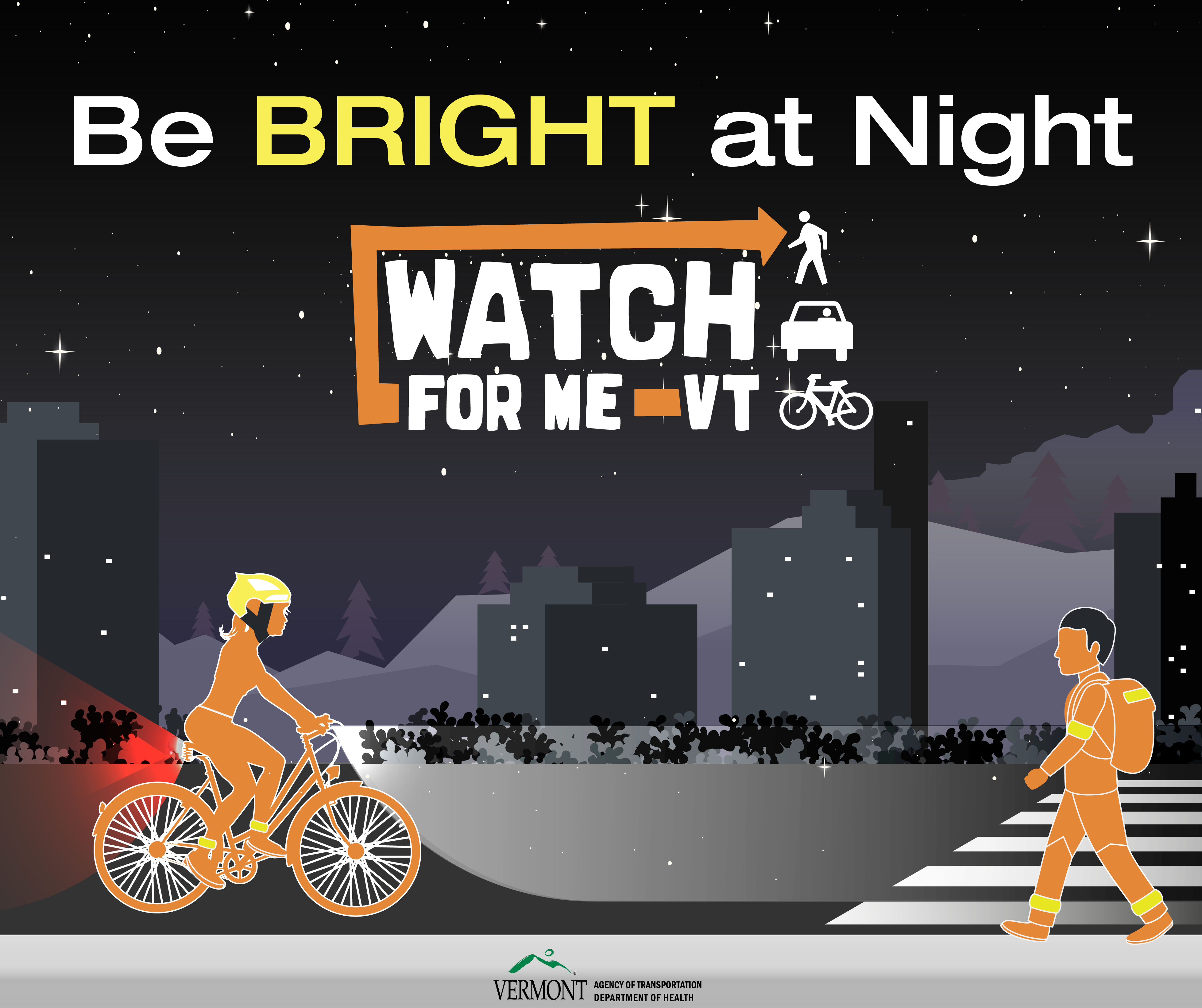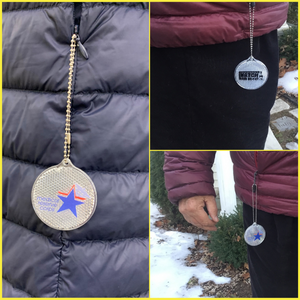
Whether you walk, drive, or bike, the shorter days of fall and winter mean it’s especially important to see and be seen on the road.
Be Bright at Night is a statewide campaign focused on night-time road safety. Our hope is to create a culture where pedestrians, drivers and municipalities collaborate to reduce injuries and deaths related to vehicle crashes involving pedestrians. Be Bright at Night focuses on grass-roots education and information to inform road-users how they can make simple changes in behavior that have lasting impact.
According to recent data from the National Highway Traffic Administration, more pedestrians were hit and killed in the U.S. in 2021 than at any time in the past 40 years. In both urban and rural areas, many motor vehicle crashes involving pedestrians and cyclists occur in the evenings and darker months of the year. Pair that with factors like speed, inattention, driver impairment, poor lighting conditions, and roadways not designed with pedestrian and cyclist safety in mind, and you have a recipe for tragedy.
Night comes earlier now that we turned the clocks back, and we need to adjust our driving and pedestrian habits. Fortunately, there is a lot we can do to keep ourselves and each other safe.
In the winter of 2022, the Watch for Me VT Program worked with Medical Reserve Corps (MRC) units and community partners to launch the Be Bright at Night Reflector Pilot Program. The program's goals were to hand out free reflectors, raise awareness of road safety issues, promote driver, pedestrian, and cyclist safety messaging, and collect data to potentially expand the program statewide. Five of the eight MRC units participated and the pilot met wide acclaim in the regions served. In 2023, the MRC secured funding from the National Association of City and County Health Officials (NACCHO) through the MRC STTRONG grant to expand this program statewide. All MRC units now provide reflectors and night-time pedestrian safety education to their communities, with a focus on at-risk groups that disproportionately spend more time outdoors in our communities on foot.
The MRC STTRONG Year One Report details the successes of the program over the course of its first year.
To request a Be Bright at Night educational presentation for your school or organization, please contact your local MRC unit.
Be Bright at Night offers the following resources:
- · Be Bright at Night rack cards in العربية (Arabic) | မြန်မာစာ (Burmese) | دری (Dari) | English | Français (French) | Kirundi | 简体字 (Chinese - Simplified) | नेपाली (Nepali) | پښتو (Pashto) | Soomaali (Somali) | Español (Spanish) | Kiswahili (Swahili) | Tingrinya | українська (Ukrainian) | Tiếng Việt (Vietnamese)
- Watch For Me VT rack cards in العربية (Arabic) | မြန်မာစာ (Burmese) | دری (Dari) | English | Français (French) | Kirundi | 简体字 (Chinese - Simplified) | नेपाली (Nepali) | پښتو (Pashto) | Soomaali (Somali) | Español (Spanish) | Kiswahili (Swahili) | Tingrinya | українська (Ukrainian) | Tiếng Việt (Vietnamese)
- · Informational videos
- · Community presentations for student and adult audiences
- · Educational resources for schools looking to incorporate Be Bright at Night into Health curricula
How to use/wear reflectors:
Reflectors should be visible from the front and the back. A reflector should dangle. Drivers notice movement more than a stationary reflection.
Attach reflectors to:
- Backpacks
- Pockets
- Zippers
- Walkers
- Wheelchairs
- Dog Leashes
- The more reflectors, the better!
A person wearing reflectors is up to 3x more visible than someone wearing dark clothing.

Be Bright At Night Video Translations
Check out this informational video on nighttime pedestrian safety, produced by the Medical Reserve Corps in conjunction with Vermont Department of Health’s Division of Emergency Preparedness, Response and Injury Prevention. The video has also been translated into several other languages, including Arabic, ASL, Bosnian, Burmese, Dari, French, Kirundi, Kreyol, Maay Maay, Mandarin, Nepali, Pashto, Spanish, Somali, Swahili,Tigrinya, Ukrainian, and Vietnamese.
Check out the following safety tips for communities, drivers, cyclists, and pedestrians:
For communities:
-
State and local governments can enact policies that protect community members while traveling, maintain existing sidewalks, add street lighting at the pedestrian level to improve the visibility of people walking and biking; and strategize about infrastructure changes to maximize community benefit.bUnder the state’s Complete Streets policy, municipalities must consider the needs of all roadway users.
-
Law enforcement can enforce laws to keep people safe as they move through their communities.
-
Media can cover stories about our transportation system and use language that does not inadvertently assign blame to victims.
When walking, biking, or rolling at night:
-
Make sure you are visible to drivers by wearing light and bright clothing, or better yet, bring flashlights/bike lights and wear something reflective.
-
If wearing reflectors, they should be visible from the front and the back. A reflector should dangle. Drivers notice movement more than a stationary reflection.
-
Cyclists are required by law to use either a flashing or steady red rear light OR a minimum of 20 square inches of reflective material facing to the rear.
-
Cross streets in well-lit areas with the best view of traffic.
-
Use sidewalks whenever possible.
- If there are no sidewalks, walk facing traffic, as far from the roadway as you can.
-
At the bus stop: cross behind the bus or in the crosswalk.
-
Watch for cars, bikes, and other vehicles – because they might not be watching for you.
When driving at night:
-
Drive slowly and carefully to leave yourself enough time to react. A pedestrian hit by a car going 40 mph has an 85% chance of being killed. At 20 mph, the risk is reduced to 5%.
-
Never drive distracted, drowsy, aggressive, or under the influence of alcohol or drugs.
-
Come to a complete stop at stop signs and red lights.
-
Stay alert, always watch for bikes and pedestrians, and share the road.
Interested in more information about the program? Consider reading the 2023 Pilot Report.
To request a Be Bright at Night educational presentation for your school or organization, please contact your local MRC unit.’ I would also like to add ‘If you do not know which unit serves your area, or for general questions, please email AHS.VDHDEPRIPMRC@vermont.gov .’
